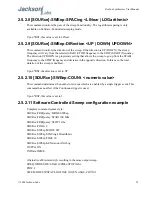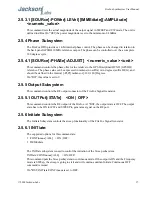
FireFox Synthesizer User Manual
22
© 2006 Jackson-Labs
The FireFox synthesizer is particularly well suited for the following applications due to its high
accuracy and resolution. These types of applications were previously difficult to achieve with
conventional equipment:
* Combining two FireFox units, and running them at slightly different frequencies (frequency offsets
as low as 10µHz can be achieved between two FireFox units) to test for equipment behavior and
failure when two slowly drifting oscillators are driving the system. This is helpful in Telecom type
applications.
* High-speed research applications in which two geographically separate locations require precisely
synchronized timing and frequency references. Precise signal synchronization anywhere on the globe
is possible due to the units’ worldwide GPS reception, and its synchronization to UTC.
* Test & measurement applications in production environments.
* Moon-bounce type research where signals with low phase noise and extremely high frequency
accuracy are required due to the very low level of the reflected RF signal.
* Generating, and measuring the effects of Audio/Video drift in broadcast applications such as
Digital TV distribution, IPTV, video-on demand etc.
* Measuring long-term drift and noise on Rubidium, Cesium, and Crystal Oscillators.
* Measuring performance of RF receivers in the presence of arbitrary jamming signals. These
jamming signals could be generated with 10µHz resolution and up to +10dbm output power by the
FireFox signal generator.
* The output phase can be controlled in 0.1 degree steps from -180 to +180 degrees, allowing very
precise alignment of signals for quadrature type applications.
* The frequency, the amplitude, and most other internal settings can be controlled via an RS-232
serial port under host-PC control, allowing automated test setups (SCPI compatible RS-232 control
firmware upgrade available Q2/2006).
1.6.2 Signal Generator Outputs
The following output signals are available on the FireFox unit:
* CMOS OUTPUT
- 3.3Vpp or 5Vpp (user selectable via back-panel switch)
A best-in-class, extremely high-speed generic CMOS compatible output can generate
frequencies from 0Hz to 350MHz, with an overrange of up to 390MHz. This output is
typically used to clock digital circuits such as microprocessors, FPGAs, DDR SDRAM
memories, and ASICs. The output is typically fed into a 50 Ohm transmission line or coax
cable, and left unterminated at the receiver. Using a 50 Ohm termination resistor at the
receiver will cause a ca. 50% reduced voltage output swing. End termination is not
recommended, but will not harm the output.
* RF OUTPUT
- 50Ohms, 2MHz to 1640MHz range, -40dbm to +10dbm (typ.)
Can be used as the local oscillator for any RF type application. Maximum power typically
ranges from +10dbm to +15dbm depending on the frequency. Has leveled output capability,
with output power selected via keypad. This output can be used as the local oscillator source
for the built-in generic Mixer (use +10dbm output max to avoid mixer damage). The RF
output requires 50 Ohm end-termination.
*
LVDS OUTPUT
- 50Ohms DC coupled 10MHz to 1640MHz 300mVpp (with a 2MHz to
10MHz underrange)
Summary of Contents for FireFox
Page 1: ...FireFox Synthesizer User Manual Document 0012008 Version 004 Date 10 April 2008...
Page 2: ...FireFox Synthesizer User Manual Copyright 2008 Jackson Labs...
Page 34: ...FireFox Synthesizer User Manual 28 2006 Jackson Labs...
Page 46: ...FireFox Synthesizer User Manual 40 2008 Jackson Labs SOURce POWer...
















































